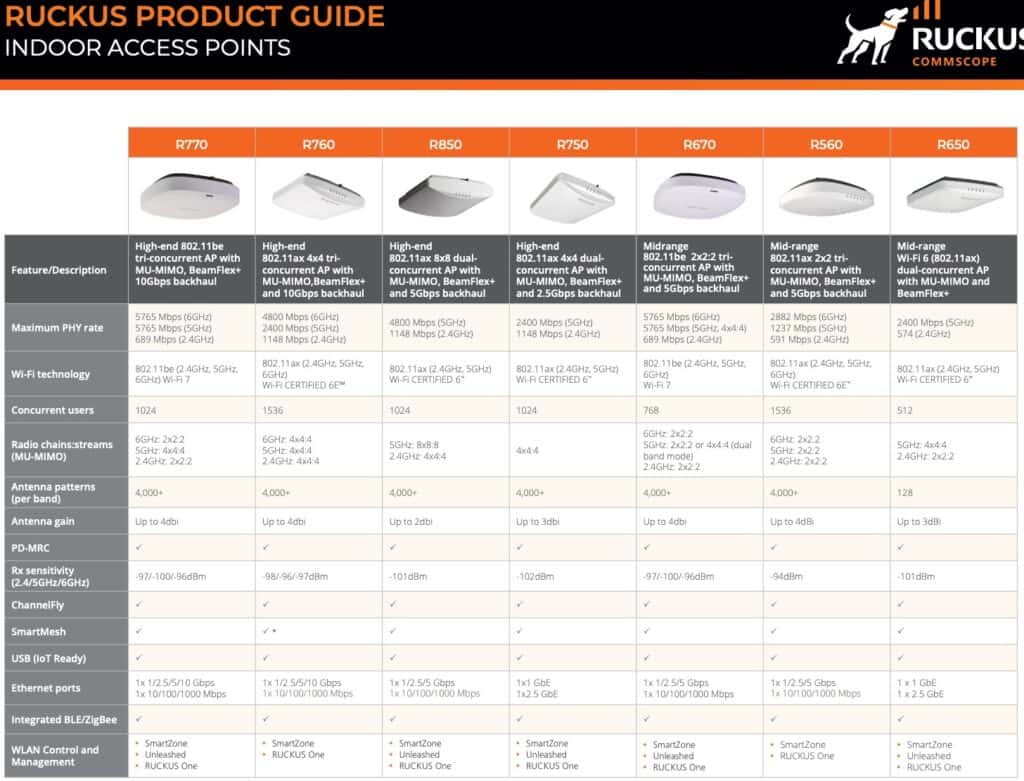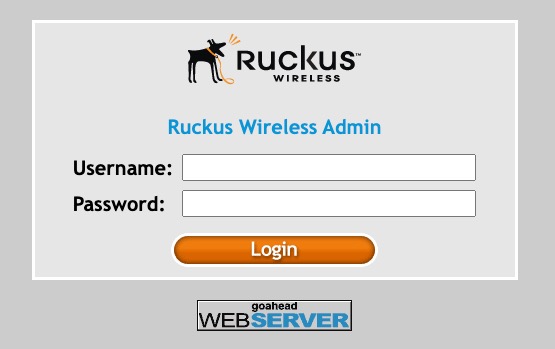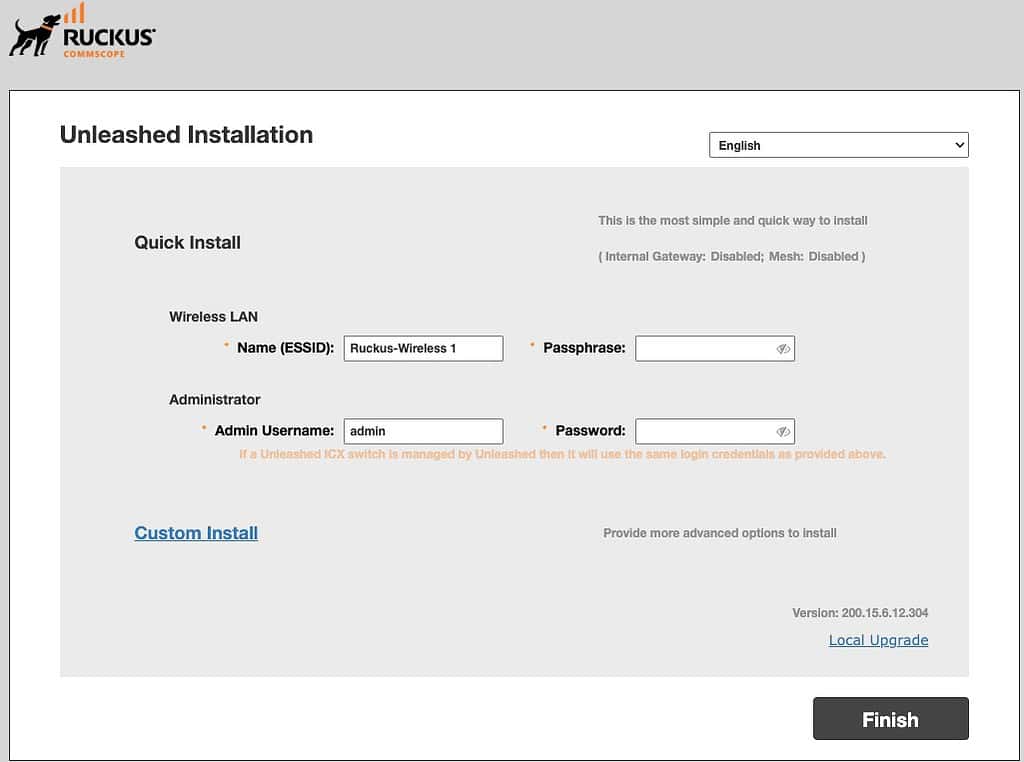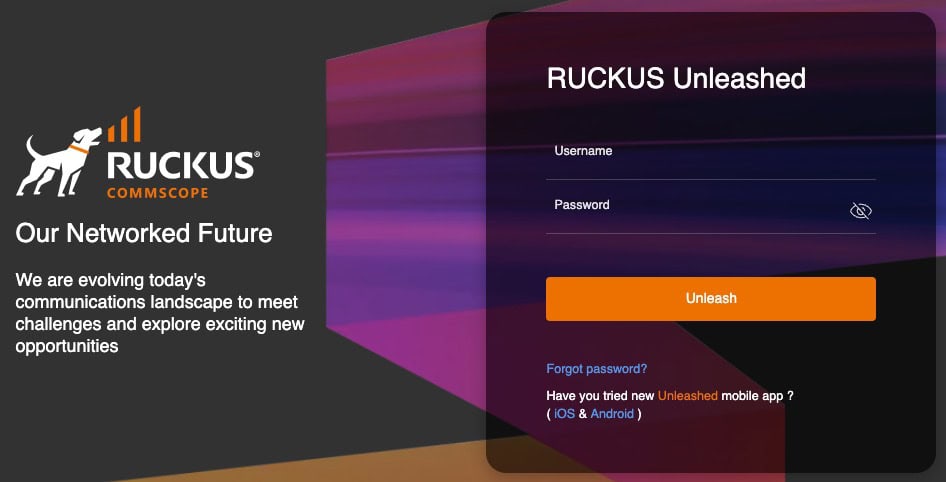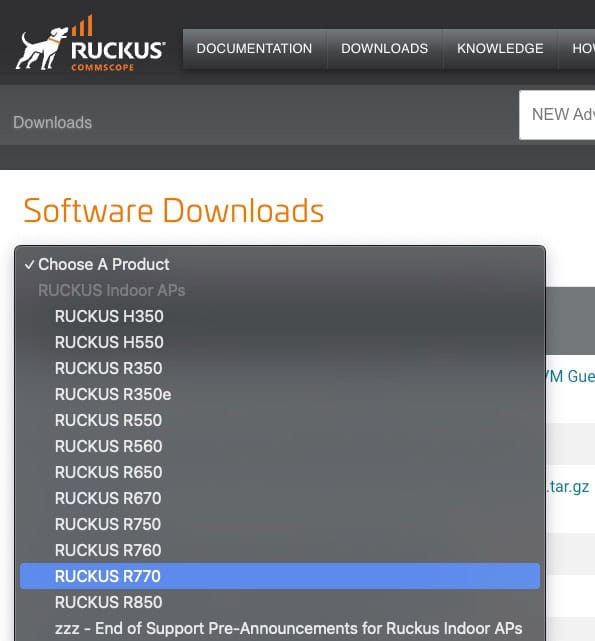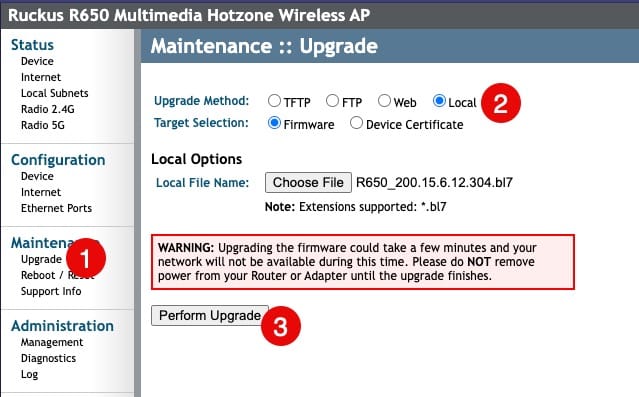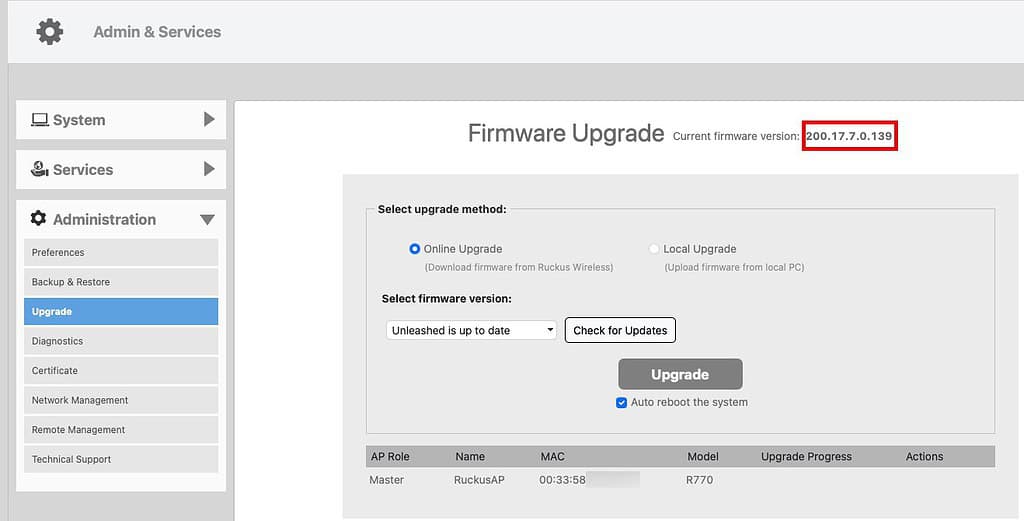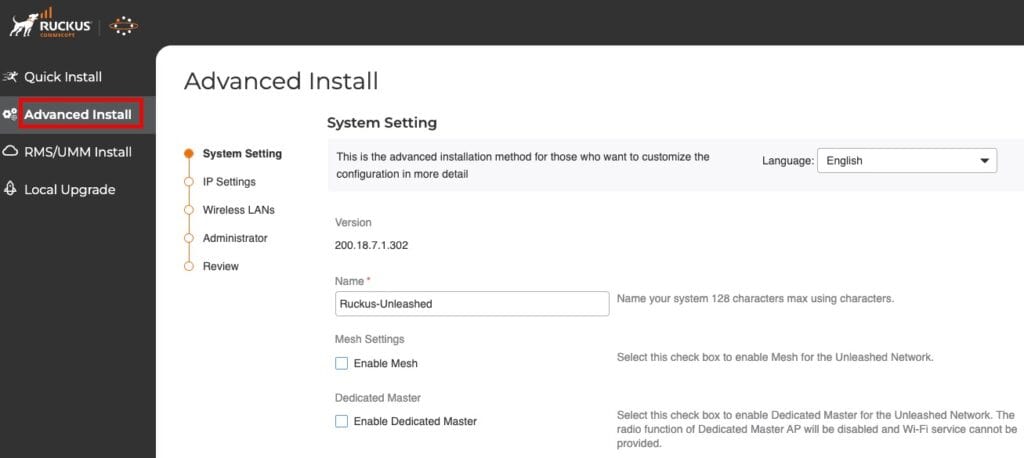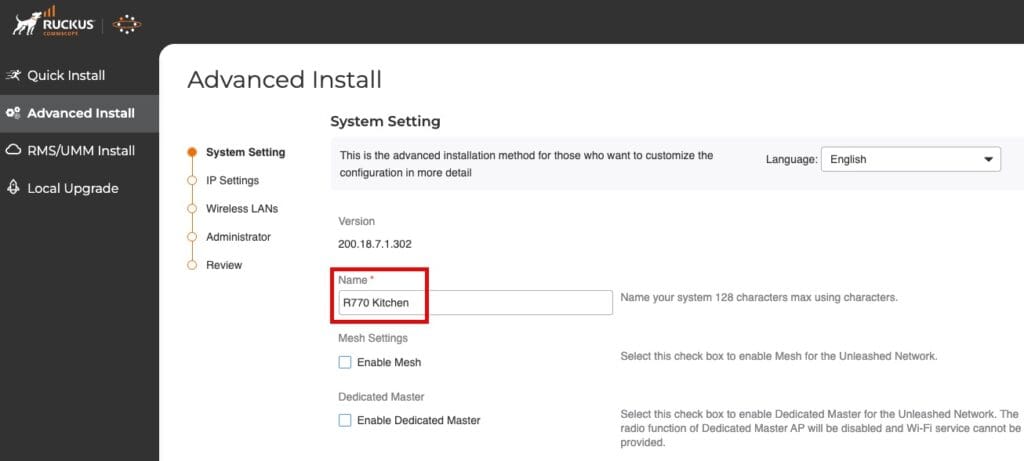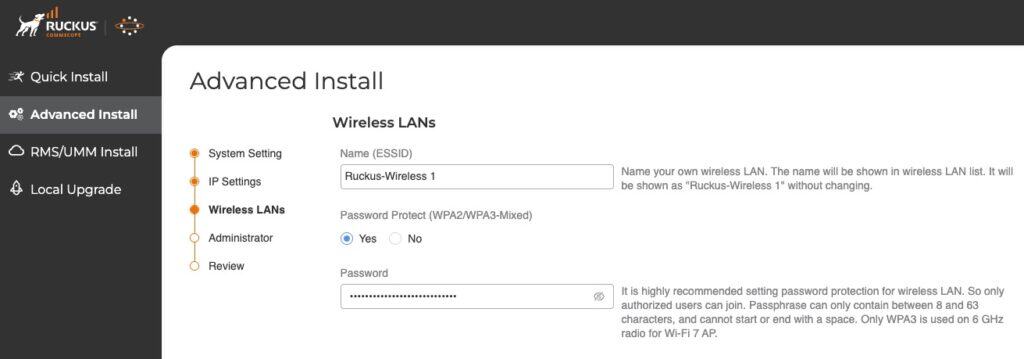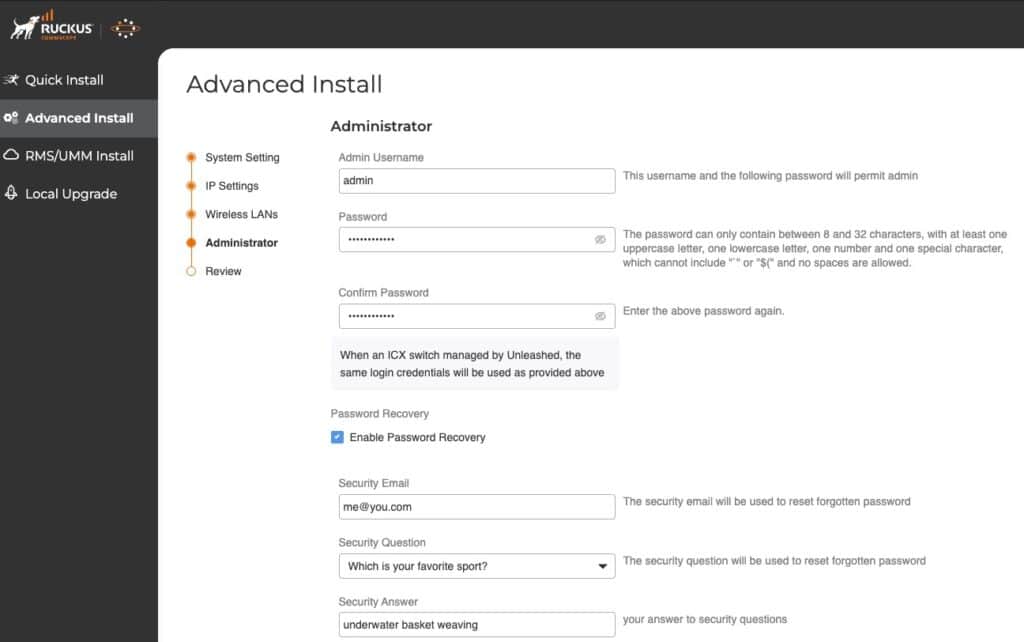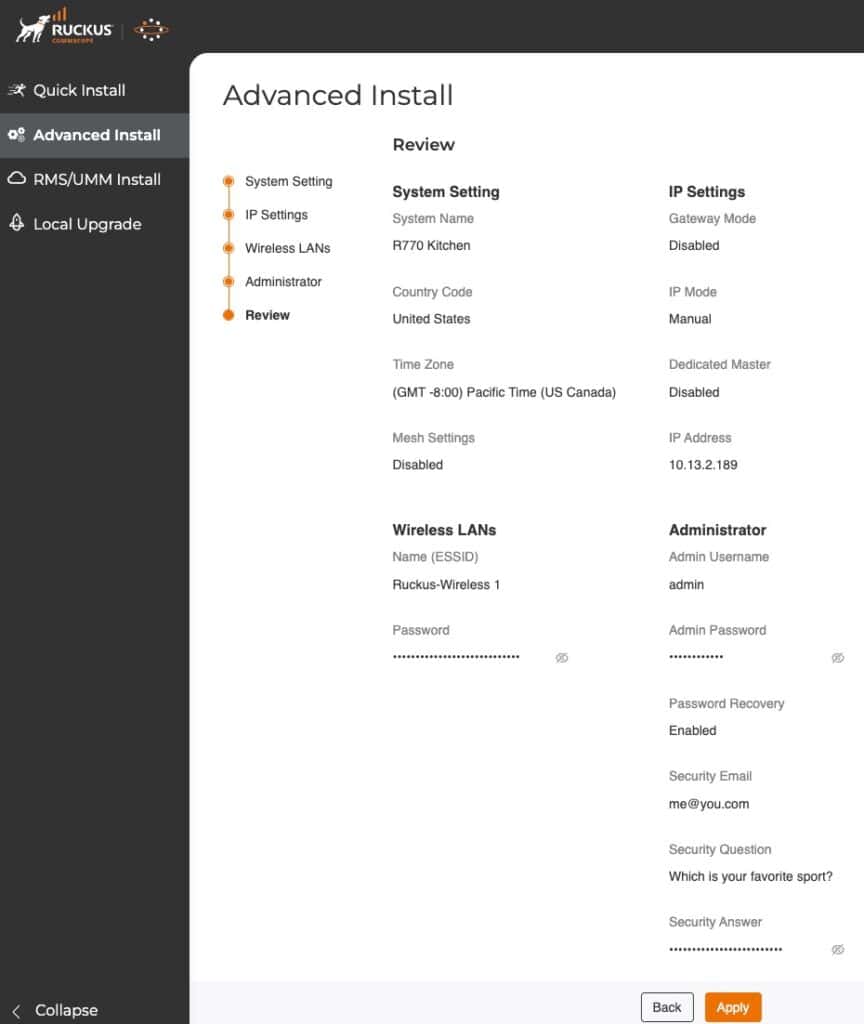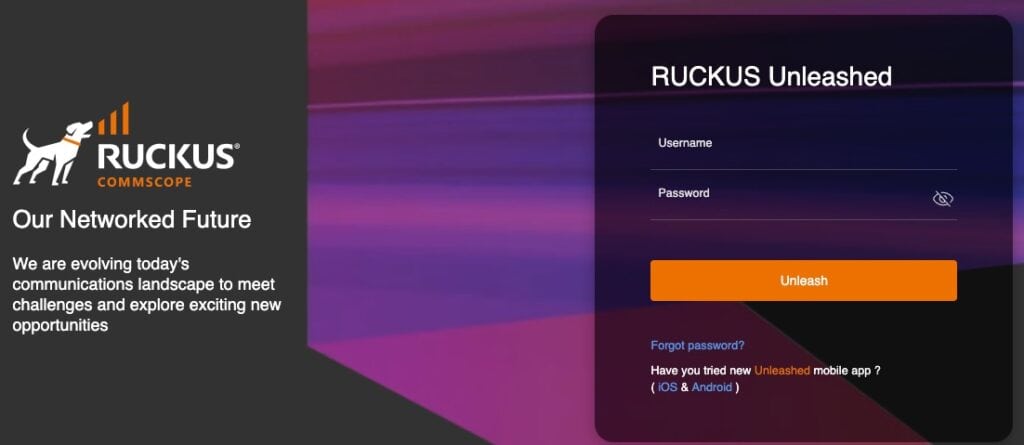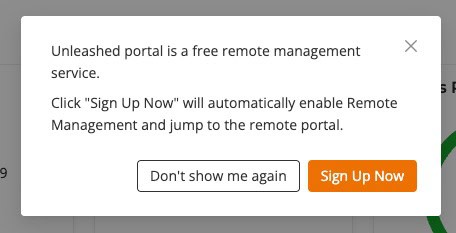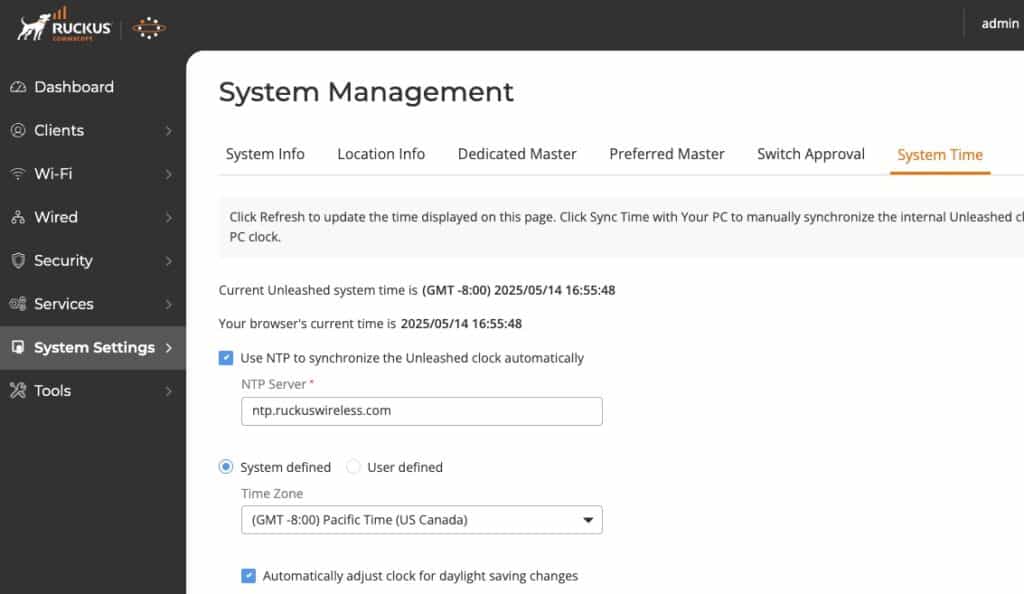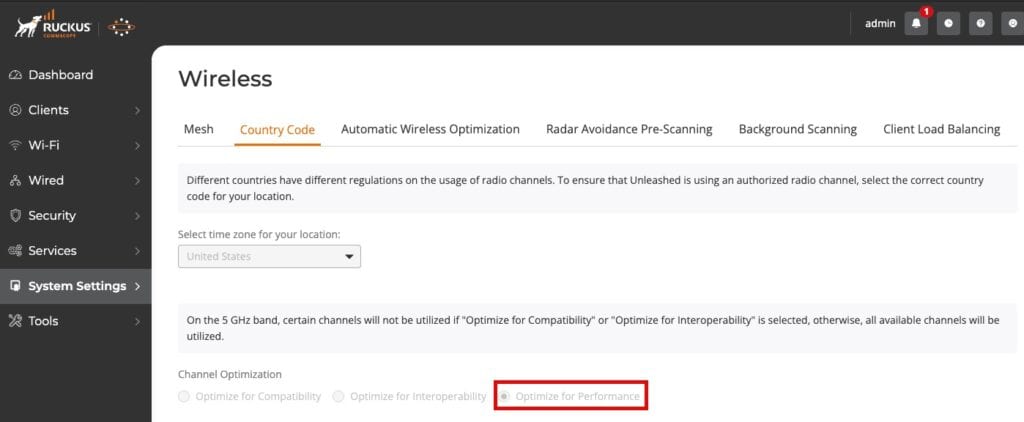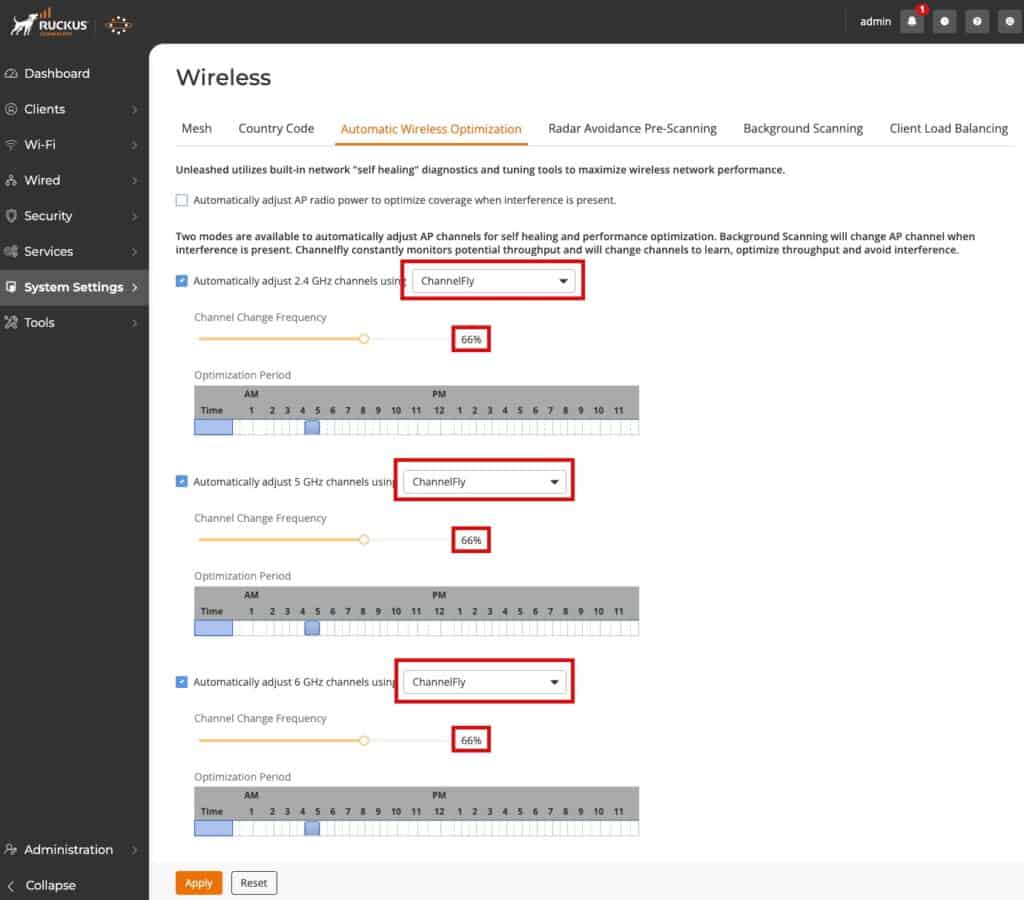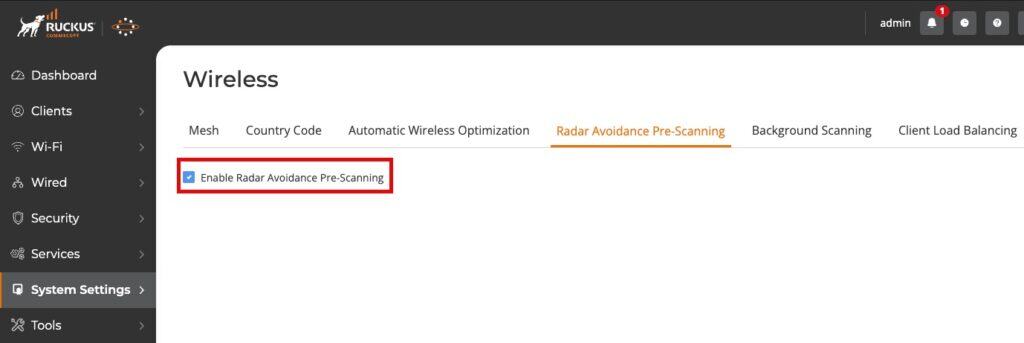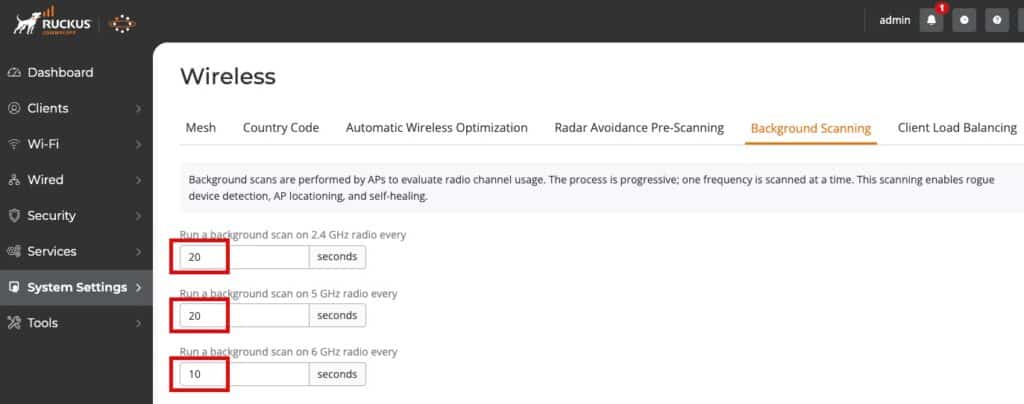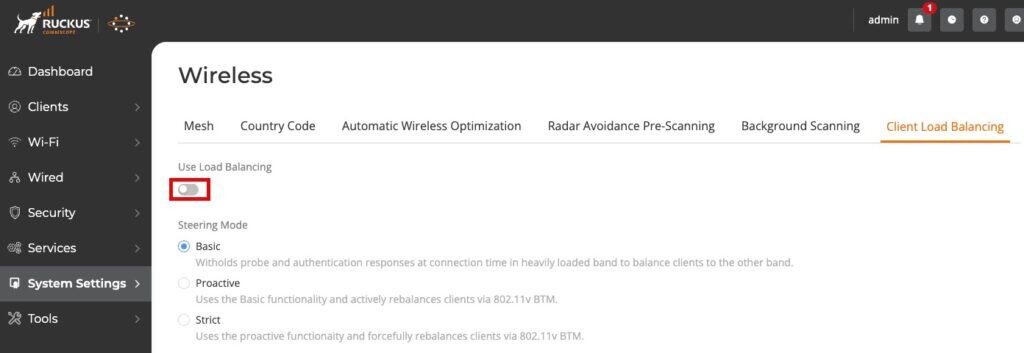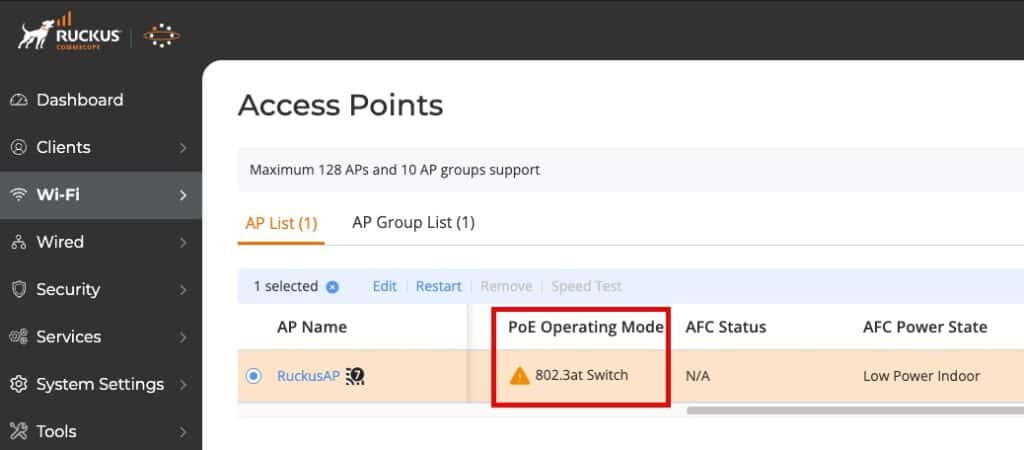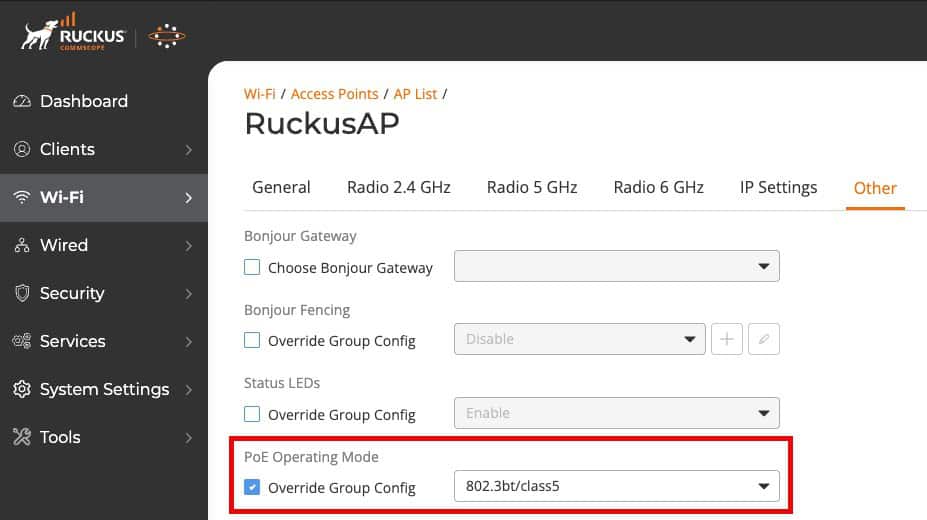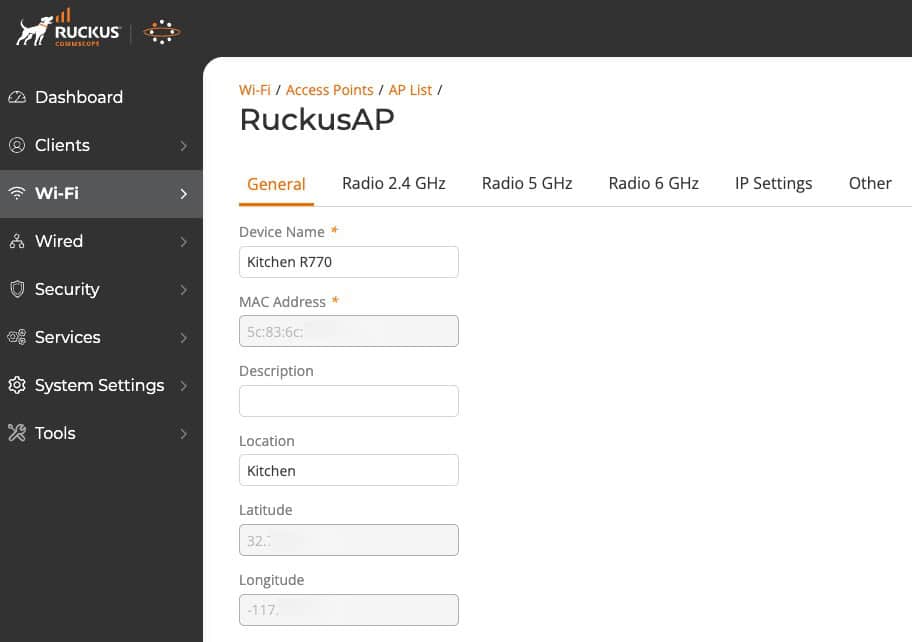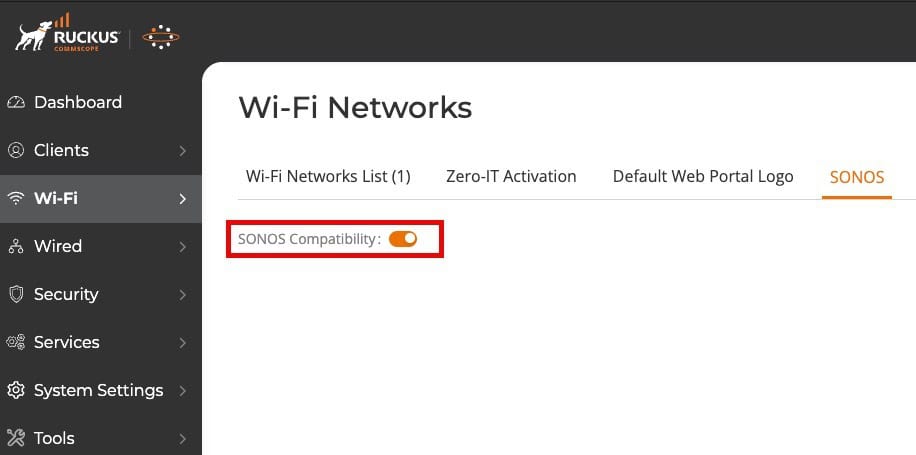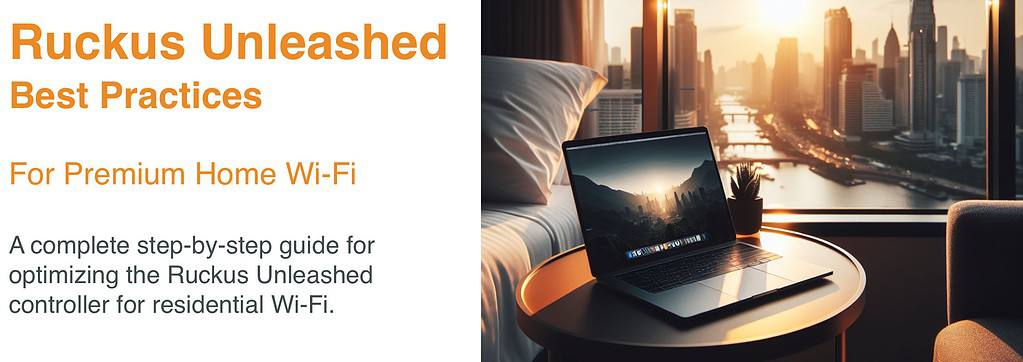
Welcome to my 2025 updated unofficial Ruckus Unleashed Best Practices Guide for enterprise-grade home Wi-Fi. This series has been completely redone to support Ruckus Unleashed 200.18 and newer. Unleashed 200.18 and later feature an entirely new UI/UX that mirrors that of their paid Ruckus One controller. IMHO, this is a huge advancement for Unleashed users, as the UI is much more modern and easy to navigate.
If you have not yet upgraded to Unleashed 200.18 or later, you can refer back to my Part 1: Ruckus Unleashed Best Practices Guide guide which covers the legacy interface used in 200.17 and earlier.
This series will guide you through the configuration of the free Ruckus Unleashed controller for a residential setting. Residential deployments can present unique challenges to maximizing Wi-Fi performance and stability. This guide provides detailed guidance on a variety of settings and presents sample Wi-Fi LAN configurations to help get you started.
Ruckus Unleashed is a high-performance local Wi-Fi controller which runs within your Ruckus access points. No external software or hardware controller is needed. Ruckus Unleashed is designed for residential and small business environments. You can check out their Ruckus Unleashed data sheet for all the details of supported models and feature set. As of late 2024 Ruckus added support to Unleashed for their Wi-Fi 7 APs, such as the R670 and R770. This is a welcomed addition to the Unleashed family.
Disclaimer: This post does not contain any affiliate links, and I did not receive any compensation from anyone for this post. Ruckus has previously provided an AP and ICX switch for testing.
Related Posts
Part 2: Ruckus Unleashed (200.18+) Best Practices Guide
Part 1: Ruckus Unleashed Best Practices Guide (200.17 and earlier)
Part 2: Ruckus Unleashed Best Practices Guide (200.17 and earlier)
Part 1: Ruckus One Home Wi-Fi Best Practices Guide
Part 2: Ruckus One Home Wi-Fi Best Practices Guide
Enterprise Grade Home Wi-Fi: Ruckus Unleashed vs. Ruckus One
Ruckus Unleashed to Ruckus One Migration Guide
Unleashing the Power of 6 GHz Wi-Fi: Re-Think Everything
Ruckus One: Provisioning ICX Switches
6 GHz Wi-Fi: Are Your Devices ready for Standard Power?
Best Practices Guide Versioning
This guide was written using the following version of firmware:
Recommended Unleashed Firmware: 200.18 MR (200.18.7.101.242)
Blog Post Change Log
May 15, 2025: Initial release
September 28, 2025: Minor updates. Bumped recommended version to 200.18.7.101.242.
What's Covered?
This series of posts will cover the entire setup of Ruckus APs with Ruckus Unleashed for a residential setting. It will also show you how to deploy various networks such as homeowner and guests. Major sections in this series includes:
- Ruckus Access Point Selection (Part 1)
- Cross-Flashing Unleashed (Part1)
- Unleashed Firmware Update (Part 1)
- Unleashed Initial Configuration (Part 1)
- System Settings (Part 1)
- Services Settings (Part 1)
- Wi-Fi Configuration (Part 1)
- SSID Architecture (Part 2)
- Guest Traffic Isolation (Part 2)
- Wi-Fi 7 Multi-Link Operations (MLO) (Part 2)
- Dynamic Pre-Shared Keys (DPSK) (Part 2)
- Wi-Fi Band Use Cases (Part 2)
- Wi-Fi Calling (Part 2)
- Firewall IPsec Passthrough (Part 2)
- 2.4 GHz Radio Configuration (Part 2)
- 5 GHz Radio Configuration (Part 2)
- 6 GHz Radio Configuration (Part 2)
- Configure Wi-Fi Network: Network Details (Part 2)
- Configure Wi-Fi Network: Zero-IT & DPSK (Part 2)
- Configure Wi-Fi Network: WLAN Priority (Part 2)
- Configure Wi-Fi Network: Access Control(Part 2)
- Configure Wi-Fi Network: Radio Control (Part 2)
- Configure Wi-Fi Network: Others (Part 2)
- Adding more Access Points (Part 2)
- Setting Preferred Master AP (Part 2)
- Troubleshooting (Part 2)
- Backup & Restore (Part 2)
- Remote Management (Part 2)
Ruckus Access Point Selection
Ruckus makes a wide variety of indoor and outdoor Wi-Fi APs. You can peruse their full portfolio for the complete list of Wi-Fi APs. For residential Wi-Fi 6 the Ruckus R650 is an outstanding AP. It represents a killer value for the performance that you can get, and is a steal on the second hand market.
Covered in their product guide, but not shown in the graphic below, are additional indoor APs such as the R350 and their “H” (hospitality) series. They also have a full line of outdoor (weather sealed) APs. As previously mentioned, not all AP models support Unleashed. If you want indoor Wi-Fi 7 APs, then you can choose between the R670 and R770, both of which support Unleashed.
Cross-Flashing Unleashed
Depending on how you acquired your access point it might be running firmware other than Unleashed. The easiest way to tell what your AP is running is by navigating to the IP address of the AP in your browser using HTTPS and looking at the login screen. If your login screen looks like the first screenshot below we will need to cross-flash your AP to the Unleashed firmware. If your browser is unable to connect to the AP’s IP via HTTPS, then we will need to enable the web interface via SSH and then cross-flash.
If you login screen looks like any of the ones below then you are already running Unleashed and do NOT need to cross-flash to Unleashed.
Enabling AP Web Interface
If your brand new Ruckus AP is not responding to HTTPS connections we need to enable the web interface. Follow these steps:
- SSH into the IP address of your AP. If AP is configured with default credentials, login with a username of super and a password of sp-admin.
- At the SSH prompt type set https enable.
- Reboot the AP by typing reboot.
- Wait a few minutes for the AP to reboot and the web interface to initialize.
- Verify you can now connect to the AP’s IP address via HTTPS.
Cross-Flashing APs to Unleashed
If you need to cross-flash your AP to Unleashed follow this procedure. If you are already on Unleashed, skip down to the next section to make sure you are on 200.18 or later. Please refer to the top of this post for the recommended firmware. On occasion the latest version is not the best option. If you are buying pre-owned older APs, such as off Ebay, the firmware flashing process should be done with Firefox. There can be issues with Chrome/Edge which cause firmware updates to fail unless you are using the very latest firmware.
- Go to the Ruckus Support site, and select your AP model.
2. Locate the appropriate version of the Unleashed firmware for your AP model. It should have a file extension of BL7. Download the file. For this best practices guide the MINIMUM AP firmware version is Unleashed 200.18 (GA). Earlier versions have an entirely different (legacy) UI.

3. Login to the access point using the default credentials of username super and password sp-admin. If those credentials do not work, you may need to do a factory reset. To do that, insert a paperclip into the reset hole and hold for 5-10 seconds, then release. Wait a few minutes for the reset to complete.
4. On the left side under Maintenance click on Upgrade. In right right pane click on Local. Browse to the BL7 file you downloaded from Ruckus.
5. Click on Perform Upgrade and wait for the AP to reboot. This will take a few minutes. After the AP reboots, you should see the 200.18 (or later) new logon screen, as shown below.
Unleashed Firmware Update
Please refer to the top of this post for the recommended firmware. On occasion the latest version is not the best option.
- In your browser connect via HTTPS to the IP of your access point. No port number is needed. Ignore any SSL certificate trust issues.
- If you see a login page like the image below, then your AP is running Unleashed 200.17 or older, and thus has the legacy interface. We need to update the AP to 200.18 or later.
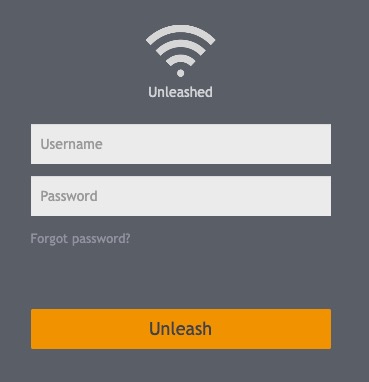
2. Login to the AP and click on Admin & Services -> Administration -> Upgrade.
3. Click on Check for Updates. If there is an update for 200.18 or later, install it and wait for the AP to reboot. If an update to 200.18 or later is not detected, click on Local Upgrade and upload the latest AP firmware for your model that is at least 200.18 or later. Wait for the upgrade process to complete and for the AP to reboot.
4. After the AP reboots, refresh your browser and you should see an entirely refreshed logon page that looks similar to the image below.
Unleashed Initial Configuration
This section assumes your Ruckus access point is already flashed with Ruckus Unleashed. If you are deploying multiple APs in your environment, you should FULLY setup the first AP, including adding all of your Wi-Fi LANs (WLANs) which I cover in Part 2. Once the first AP is setup, also known as the Master, you can deploy additional APs and they will automatically inherit your configuration. This means completing both Parts 1 and 2 of this series on your first AP. Only after your first AP is fully setup should you power on your other APs.
Tip: Prior to configuring ANY of your APs I would bring them ALL up to the same firmware version. For the purposes of this guide the minimum Unleashed version is 200.18.
- Make sure ALL of your APs are powered off.
- Plug in one AP to your network and provide power (PoE, or power brick). Lights should start blinking shortly after applying power. Give it a few minutes to fully boot.
- Open your favorite browser and connect via HTTPS to the IP of your access point. Consult your router’s DHCP table or use other means to find out the IP that it pulled. Ignore any SSL certificate warnings.
- On the left click Advanced Install on the Unleashed landing page. If you see any other page, then either 1) The AP isn’t running Unleashed firmware (see cross-flashing section above) or 2) If you see the Unleashed username/password screen then you need to do a full AP reset. To do a reset put a paperclip in the reset hole on the AP and hold for 15 seconds. Release then wait a few minutes for the AP to reset.
5. Change the AP name to anything you desire. I like to use model number and location. See graphic below.
6. I’m assuming that all of your Ruckus APs will be using an Ethernet backhaul. This means even if you are deploying multiple Ruckus APs you should NOT select Enable Mesh. This option is only for wireless backhauls, which is strongly NOT recommended.
7. Unless you have a very special use case in mind, do NOT check the Enable Dedicated Master box. A dedicated master is typically only used in larger Unleashed deployments (think SMB, small hotel, etc.) where you want to disable the radios on an AP and devote all the CPU and memory resources to the Unleashed controller.
8. Click Next.
9. I strongly suggest using a fixed (manual) IP address for all of your APs. Or you could make DHCP reservations for each AP and leave the AP in DHCP client mode. For my use case I prefer the full manual route. Enter the AP’s IP address, netmask, Gateway and DNS server information.
10. If for some reason you do NOT already have a DHCP server on your network, Unleashed supports a built-in DHCP server. Should you want to enable this functionality, toggle the DHCP server switch in the right pane. 99% of you probably won’t be using this feature.
11. Click Next.
12. On the Wireless LANs page I would configure DUMMY information. Later on in this guide I’ll cover a suggested WLAN architecture and detailed settings.
13. Click Next.
14. Configure the Unleashed Administrator credentials. I would suggest enabling the new password recovery feature, just in case you lose the master password. Make sure you save these credentials in your password manager of choice.
15. Click Next.
16. On the Review page double check all information is correct, then click Apply.
17. Unleashed will now start to build the controller. This can take several minutes, so be patient.
18. Wait for the Congratulations screen. Ignore the IP address and port number shown on the screen. Now that Unleashed is running, go to the next section for additional configuration.
System Settings
The following settings are at the system level and prepare Unleashed so that we can then start provisioning Wi-Fi LANs (WLANs) in Part 2.
- In your browser navigate to the IP address of the AP using HTTPS. Ignore any certificate warnings. You should see a login screen like the one below.
2. After you login for the first time you may see a popup for the free Unleashed portal. We’ll cover that later in Part 2 of this series, so click Don’t show me again.
System Time
Assuming the APs are connected to the internet they will, by default, use ntp.ruckuswireless.com as their NTP server. Unless you have a specific reason to change the NTP server, leave it as the default value. We also need to change the timezone and daylight savings.
- Navigate to System Settings -> System Time.
- Select your timezone. If your location observes daylight savings times check the box. Click Apply.
Country Code and Channel Mode
1. Navigate to System Settings -> Country Code.
2. Verify your country is selected and click on Optimize for Performance (if not already selected). Click Apply if needed.
Optimize for performance enables what are called DFS channels. These channels can overlap with radar in your area, such as those used at airports. However, the APs can detect radar events and change channels as needed. Unless you run into issues with frequent radar events that create issues for your 5 GHz devices, I would use the DFS channels. Most consumer and ISP APs don’t use DFS channels, so this can be a great opportunity to use channels that have little to no interference.
Optimize for compatibility uses UNII-1 and UNII-3 channels (36-48, 149-165). Optimize for performance adds UNII-2a and UNII-2c, depending on your region. These are channels 52-144. See the graphic below for more details.
Tip: Some badly designed devices may not deal with DFS channels. For example, old Amazon Fire TV devices did not support channels 52-144. If you have old devices that don’t like DFS channels you can 1) Upgrade the device 2) Disable the DFS channels (52-144). For the purposes of this series I’ll assume your clients are DFS compatible. However, in Part 2 you can modify which channels are used on the 5 GHz band, if needed to work around broken clients.
Automatic Wireless Optimization
- Click on the Automatic Wireless Optimization tab.
- Change the 2.4 GHz and 5 GHz modes to ChannelFly. 6GHz should already be set to ChannelFly.
- Modify the Channel Change Frequency for ALL bands to 66%.
Note: The Channel change frequency setting is basically a confidence threshold of improvement. You don’t want your APs chasing small gains and needlessly flipping channels.
4. If you want to modify the time slot for the optimization to run, you can move or expand the blue box on the timeline as you wish.
Radar Avoidance Pre-Scanning
When using DFS channels it is imperative that you enable the Radar Avoidance Pre-Scanning feature. This will scan the airwaves for any nearby radar signals and adjust Wi-Fi channel allocation as needed.
- Click on the Radar Avoidance Pre-Scanning tab.
- Ensure the checkbox is enabled.
Background Scanning
- Click on the Background Scanning tab.
- For 2.4 GHz and 5 GHz radios change the time to 20 seconds.
- For the 6 GHz band use 10 seconds.
- Click Apply.
Tip #1: Background scanning plays a role in rogue AP detection and discovering RF neighbors. A good value to start with is 20 seconds. If you are in a sparse RF environment (think rural), you could even increase this up to 60 seconds.
Tip #2: Sometimes in high interference locations Channelfly will ‘flip flop’ frequently between channels. If notice frequent channel changes which cause client connection issues, you can decrease the scanning frequency. If you find yourself in this situation, consider increasing this to 600 seconds, then monitor.
Client Load Balancing
- Click on the Client Load Balancing tab.
- I do NOT recommend you use load balancing. So leave this in the DISABLED state.
- Leave the Steering mode set to Basic.
Location Information
If your AP supports the 6 GHz band, then you might want to consider enabling AFC (Automated Frequency Coordination). This feature utilizes a Ruckus service to determine if the AP can transmit at “Standard Power”, or just the default of “LPI” which is Low Power Indoor. Depending on your Wi-Fi clients and their capabilities, you may or may not want to enable Standard Power mode. If you want to use Standard Power mode, we need to first configure the GPS coordinates and AFC Height.
- Navigate to System Settings -> Location Info -> System Location.
- Enter the Location name, Latitude and Longitude of your location.
- Click Apply.
4. Click on AFC Height.
5. Enter the minimum and maximum floors that your APs will occupy.
6. Click on Apply.
Services Configuration
Email Server (Optional)
1. Navigate to Services -> Email Server.
2. If you want to enable email alerts, configure the SMTP settings as needed. I personally use a Synology NAS as an email relay gateway to my commercial email provider.
3. After entering your SMTP information, click Test and validate it works.
4. Click Apply.
Wi-Fi Configuration
PoE Troubleshooting
Ruckus APs use LLDP to negotiate their PoE request to the upstream switch. Depending on the compatibility with your upstream switch, the AP may complain about insufficient power. You can see this warning by going to Wi-Fi -> AP List. If there is a power issue you will see an orange warning symbol, as shown below.
If you see this error, first validate that your switch can support the proper power mode, which is probably 802.3at (AP model dependent). This is commonly referred to as PoE+ and can support up to 25.5w to the end device (AP). Once you’ve verified your switch can provide the proper power, we can override the LLDP negotiation.
- Click on the radio button next to the AP in question, then click on the blue Edit button.
- Click on the Other tab, check the Override Group config and select 802.3at PoE (or the highest PoE level for your AP). For the R770 select 802.3bt/class5.
- Click Apply.
- Go back to the AP List, make sure the AP is still selected, and click Restart. Wait for the AP to reboot, and login to Unleashed.
5. Navigate to Wi-Fi -> AP List and verify there is no longer a power warning for the AP.
Note: If your switch does not support PoE+ (802.3at) or higher, you can use a mid-span power injector or the AC power brick to power your AP. Ruckus has a 10G 60w PoE injector that works perfectly with all of their APs. Also, higher power Wi-Fi access points such as the R770 require additional power, using 802.3bt5 (40w).
My core switches are Netgear M4300-16x, which “only” support 802.3at (PoE+, 25w). However, under my residential operating conditions my R770s only draw about 14w, well under the 802.3at maximum. By manually forcing 802.3bt5 (PoE++) the R770 will operate at full radio power, even though my network switch can’t supply the maximum theoretical power draw of a R770. This “trick” would probably not work in an environment where the AP is supporting hundreds of clients and could draw more than 25w of power.
Access Point Name and Location
Naming your access points and providing GPS coordinates is always a good idea. To get the GPS coordinates of your location you can use the latlong.net converter.
- Navigate to Wi-Fi -> AP List -> Click on your AP -> Edit.
- On the General tab change the Device Name, Description, Location as desired.
- In my case the lat/long are unchangeable, but are correct values, so I left them alone.
Sonos Configuration
In all residential settings I would ENABLE the Sonos compatibility mode, even if you don’t have Sonos speakers. By enabling it now you can potentially head off future issues in your home should you add them later and forget that this setting exists.
- Navigate to Wi-Fi -> SONOS. Enable SONOS Compatibility.
Summary
This is part one of two of my completely refreshed 2025 version of the Ruckus Unleashed for Residential Wi-Fi best practices guide. The guide has been fully updated for Unleashed 200.18, and later.
Ruckus Unleashed is a free Wi-Fi controller which is local and resides inside your APs. It’s entirely free and there’s no cloud component. It’s a great way to get started with Ruckus Wi-Fi APs.
In this first part we covered a number of topics including Ruckus AP model selection, cross-flashing Unleashed, updating the firmware, and a number of system settings. In Part 2 we cover a wide range of areas including SSID architecture, guest traffic isolation, dynamic pre-shared keys, and much more.
The second and final post in this series covers all remaining configuration tasks, such as tuning each radio and setting up SSIDs. Please check out Part 2 here.
